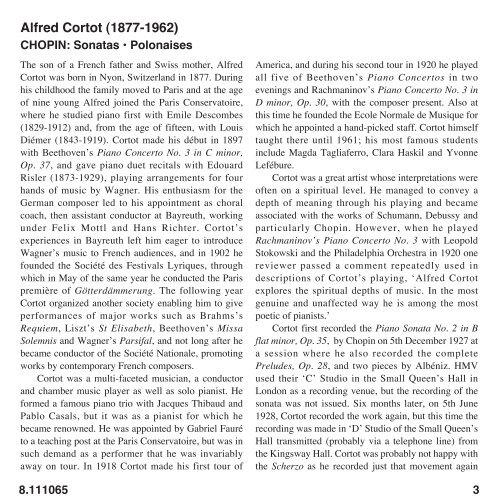CHOPIN Piano Sonatas Nos. 2 and 3 Polonaises Alfred Cortot
CHOPIN Piano Sonatas Nos. 2 and 3 Polonaises Alfred Cortot
CHOPIN Piano Sonatas Nos. 2 and 3 Polonaises Alfred Cortot
Create successful ePaper yourself
Turn your PDF publications into a flip-book with our unique Google optimized e-Paper software.
<strong>Alfred</strong> <strong>Cortot</strong> (1877-1962)<br />
<strong>CHOPIN</strong>: <strong>Sonatas</strong> • <strong>Polonaises</strong><br />
The son of a French father <strong>and</strong> Swiss mother, <strong>Alfred</strong><br />
<strong>Cortot</strong> was born in Nyon, Switzerl<strong>and</strong> in 1877. During<br />
his childhood the family moved to Paris <strong>and</strong> at the age<br />
of nine young <strong>Alfred</strong> joined the Paris Conservatoire,<br />
where he studied piano first with Emile Descombes<br />
(1829-1912) <strong>and</strong>, from the age of fifteen, with Louis<br />
Diémer (1843-1919). <strong>Cortot</strong> made his début in 1897<br />
with Beethoven’s <strong>Piano</strong> Concerto No. 3 in C minor,<br />
Op. 37, <strong>and</strong> gave piano duet recitals with Edouard<br />
Risler (1873-1929), playing arrangements for four<br />
h<strong>and</strong>s of music by Wagner. His enthusiasm for the<br />
German composer led to his appointment as choral<br />
coach, then assistant conductor at Bayreuth, working<br />
under Felix Mottl <strong>and</strong> Hans Richter. <strong>Cortot</strong>’s<br />
experiences in Bayreuth left him eager to introduce<br />
Wagner’s music to French audiences, <strong>and</strong> in 1902 he<br />
founded the Société des Festivals Lyriques, through<br />
which in May of the same year he conducted the Paris<br />
première of Götterdämmerung. The following year<br />
<strong>Cortot</strong> organized another society enabling him to give<br />
performances of major works such as Brahms’s<br />
Requiem, Liszt’s St Elisabeth, Beethoven’s Missa<br />
Solemnis <strong>and</strong> Wagner’s Parsifal, <strong>and</strong> not long after he<br />
became conductor of the Société Nationale, promoting<br />
works by contemporary French composers.<br />
<strong>Cortot</strong> was a multi-faceted musician, a conductor<br />
<strong>and</strong> chamber music player as well as solo pianist. He<br />
formed a famous piano trio with Jacques Thibaud <strong>and</strong><br />
Pablo Casals, but it was as a pianist for which he<br />
became renowned. He was appointed by Gabriel Fauré<br />
to a teaching post at the Paris Conservatoire, but was in<br />
such dem<strong>and</strong> as a performer that he was invariably<br />
away on tour. In 1918 <strong>Cortot</strong> made his first tour of<br />
8.111065<br />
America, <strong>and</strong> during his second tour in 1920 he played<br />
all five of Beethoven’s <strong>Piano</strong> Concertos in two<br />
evenings <strong>and</strong> Rachmaninov’s <strong>Piano</strong> Concerto No. 3 in<br />
D minor, Op. 30, with the composer present. Also at<br />
this time he founded the Ecole Normale de Musique for<br />
which he appointed a h<strong>and</strong>-picked staff. <strong>Cortot</strong> himself<br />
taught there until 1961; his most famous students<br />
include Magda Tagliaferro, Clara Haskil <strong>and</strong> Yvonne<br />
Lefébure.<br />
<strong>Cortot</strong> was a great artist whose interpretations were<br />
often on a spiritual level. He managed to convey a<br />
depth of meaning through his playing <strong>and</strong> became<br />
associated with the works of Schumann, Debussy <strong>and</strong><br />
particularly Chopin. However, when he played<br />
Rachmaninov’s <strong>Piano</strong> Concerto No. 3 with Leopold<br />
Stokowski <strong>and</strong> the Philadelphia Orchestra in 1920 one<br />
reviewer passed a comment repeatedly used in<br />
descriptions of <strong>Cortot</strong>’s playing, ‘<strong>Alfred</strong> <strong>Cortot</strong><br />
explores the spiritual depths of music. In the most<br />
genuine <strong>and</strong> unaffected way he is among the most<br />
poetic of pianists.’<br />
<strong>Cortot</strong> first recorded the <strong>Piano</strong> Sonata No. 2 in B<br />
flat minor, Op. 35, by Chopin on 5th December 1927 at<br />
a session where he also recorded the complete<br />
Preludes, Op. 28, <strong>and</strong> two pieces by Albéniz. HMV<br />
used their ‘C’ Studio in the Small Queen’s Hall in<br />
London as a recording venue, but the recording of the<br />
sonata was not issued. Six months later, on 5th June<br />
1928, <strong>Cortot</strong> recorded the work again, but this time the<br />
recording was made in ‘D’ Studio of the Small Queen’s<br />
Hall transmitted (probably via a telephone line) from<br />
the Kingsway Hall. <strong>Cortot</strong> was probably not happy with<br />
the Scherzo as he recorded just that movement again<br />
3






